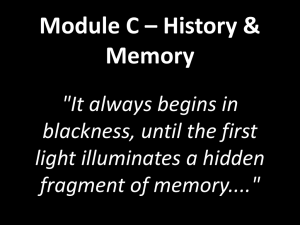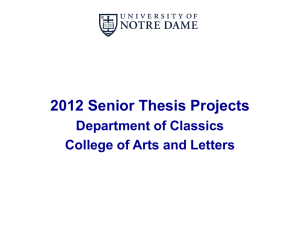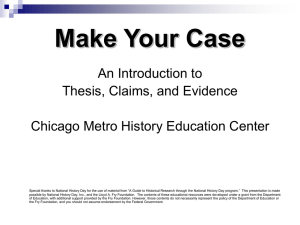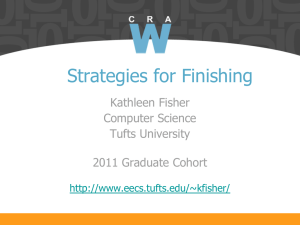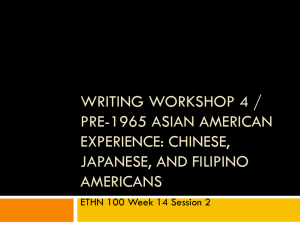Introduction
advertisement
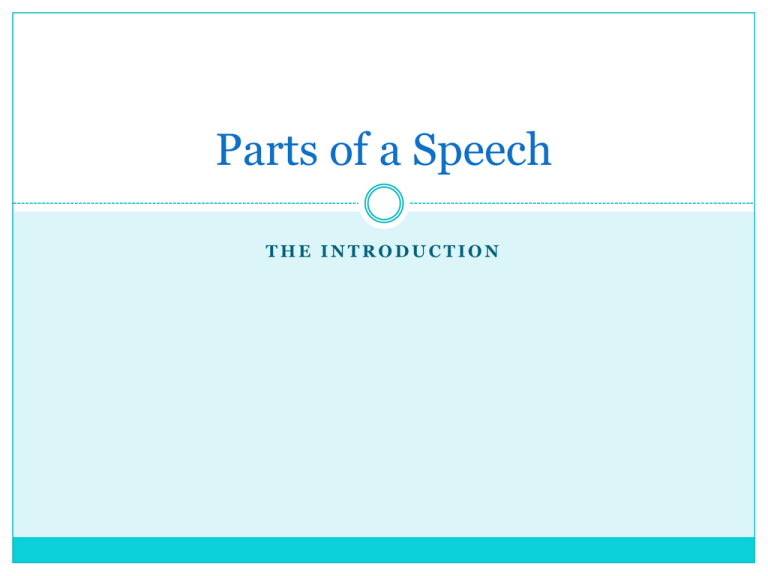
Parts of a Speech THE INTRODUCTION Purpose of an Introduction 1. Its gets the attention of the audience. 2. It provides a clear link from your attention-getter to your speech topic, or thesis statement. 3. It gives your specific thesis statement. 4. It presents a preview of the major areas that will be discussed. Sample Introduction #1 Have you ever heard the saying, “Let a smile be your umbrella”? What about the observation, “Laugh and the world laughs with you”? Both of these statements deal with how a positive attitude and a sense of humor can make a bad situation a little bit better both for you and the people around you. #2 However, did you know that your ability to laugh can mean a great deal more than a pleasant smile or momentary delight? As a matter of fact, laughter can be very beneficial in many ways. #3 Consequently, I would like to discuss the various areas in your lives where laughter can play a significant positive role. #4 Let’s take a look at how laughter can help you on the job, with your friends and family, and with your health. Attention-Getters The first words you say to your audience must make them want to listen to you. You must “grab” your audience’s attention or “hook” them into your topic. We will examine five types of attention-getters. Attention-Getter #1 Asking Questions Fires up the audience’s curiosity about your topic Makes the audience active participants in your speech A Note of Caution Sometimes you might ask your audience to raise their hands or to speak out loud. While this may lead to spirited audience involvement, it can also create chaos and a loss of concentration. Consider using rhetorical questions that don’t demand a verbal response, but they still encourage your audience to think about your topic. Attention-Getter #1 Examples: For a speech on the power of vocabulary: “How many of you know the meaning of the word verisimilitude? How about veracity? What about the word verity? ….. For a speech on shifting blame: Have you ever heard someone say, “The devil made me do it”? Have you heard the expression, “Don’t blame me; it’s not my fault”? …. Attention-Getter #2 Making References Allows you to work well with your audience You might refer to people in the audience, your physical surroundings, other speakers the group has heard, or the significance of the occasion. Allows you to be comfortable, congenial, and conversational with the audience Attention-Getter #2 Examples: “I see that Bob and Ina are in the audience. When we first started this class project over two months ago, they were the ones who provided the leadership and enthusiasm that the rest of us needed at that time. The word leadership is exactly what I wish to talk about tonight…. “for some reason, every time that we are in this classroom, the air-conditioning is out. Maybe we should all bring our own fans next time.. However, the temperature might not be the only thing that is ‘sticky’ today. My topic, “Why AIDS Needs to Be Talked about in Schools” could also make people warm and uncomfortable…. Attention-Getter #3 Making a Startling Statement Jolts the audience into paying attention Research your topic looking for data or studies that might surprise listeners and make them even more interested in the topic. A Note of Caution Be careful not to offend your audience. Attention-Getter #3 Example: A student spoke to a high school about the problems associated with violence in society. While she spoke, she comfortably moved her right hand as if she were “keeping the beat” to a song only she heard… I love music. I love dancing. I love how men and women, young and old, rich or poor, can move and smile and laugh and keep rhythm to their favorite songs. However, I’m not here to talk about music—because, ironically, every time that my hand comes down to “keep the beat,” a young child is physically or sexually abused in this country. Attention-Getter #4 Giving a Quotation Delivering the exact words that someone else has said can add a degree of style and sophistication to your speech. Quotes are abundant and fairly easy to find. Select quotes that are clear and appropriate for your speech topic and select authors who are reliable and trusted. Be sure to give your audience some idea of who the author is and what he or she has done that his noteworthy. Keep in mind that your quote does not have to be serious or from an author who lived centuries ago; quotes that are light and written by people living can be effective too. Attention-Getter #4 Examples: For a speech on “What Has Happened to Friendship?” “First in war—first in peace—and first in the hearts of his countrymen.” These are the words that began the Revolutionary War General Henry Lee’s famous funeral oration for George Washington. The quotation shows us a man of conscience and a man who cared for his fellow man. However, do we care for our fellow man the same as Washington did in his day?.... For a speech on why people are gullible: “You can fool all of the people some of the time and you can fool some of the people all the time, but you can’t fool all of the people all of the time.” Abraham Lincoln, the author of this quotation, might have added the words “except in America,” because Americans are often easy prey for those wishing to make a fast buck…. Attention-Getter #5 Telling a Story Everyone loves a well told story. Illustrations and personal accounts quickly give you an “in” with your audience because it allows you to show your personality. Your story should be short and to the point; it should hold the interest of the audience yet lead clearly into your speech topic. Personal experiences that were special or a heart-stopping ordeal can be effective, but your story does not have to be personal. Interesting accounts about other people, places, events, etc. can be effective too. Attention-Getter #5 Example: For a speech that will talk about what fear means… A few weeks ago, my mom and dad had gone out for the evening and I was alone at home. At about 2 A.M. I heard a noise by the downstairs window. Even though I hoped that the sounds would go away, they didn’t. As a matter of fact, they got louder. It sounded as if someone was struggling to reach the latch of the window. I was petrified, but somehow I managed to go downstairs. Slowly, I moved the curtain to see what was outside. You can imagine my fear when I saw two eyes looking right back at me. It was a raccoon! … The Link The link serves two purposes. 1. The link is the statement between the attention-getter and the thesis statement and it logically connects the two. 2. The link should develop a bridge between the audience and the topic. Your objective, just as with the attention-getter, is to connect with the audience members so that they are motivated to listen to your topic. The Thesis Statement Your thesis should both clarify the overall goal of your speech (to inform, to persuade, or to entertain) and state your specific topic. Your thesis should also clarify your specific slant or angle on your topic. This will help insure that you keep your speech focused and your information on target. Your job for the rest of the period…. Find a group of 3-4 people Take the topic: FORT COLLINS HIGH SCHOOL. Decide how you would focus this topic into a speech. Write an ‘attention-getter’ that fits under each type we just discussed (5). Share ideas Write a full introduction based on your favorite attention-getter. You will need to include all four parts of an introduction.


